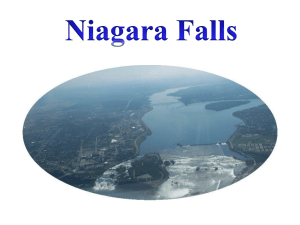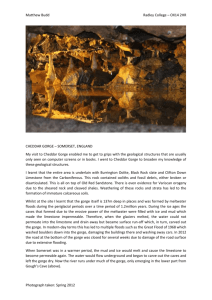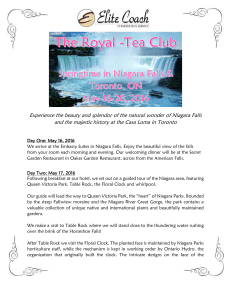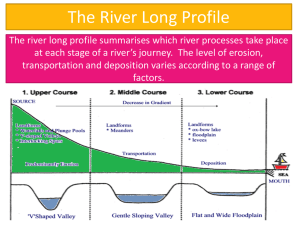File Niagara Falls1
advertisement
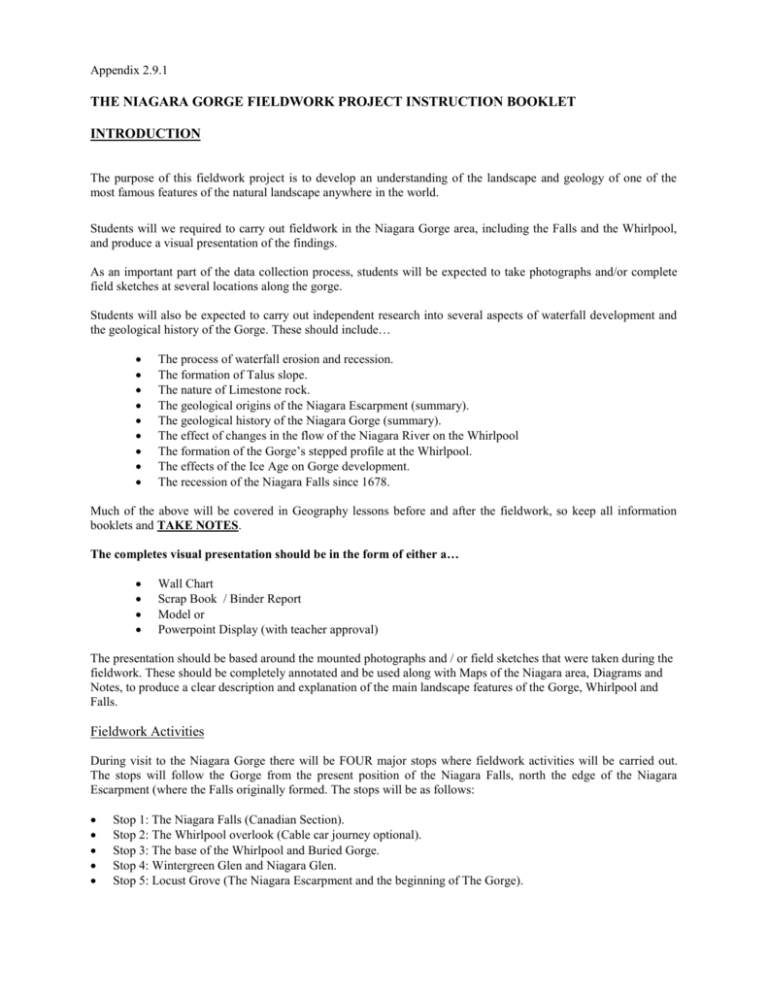
Appendix 2.9.1 THE NIAGARA GORGE FIELDWORK PROJECT INSTRUCTION BOOKLET INTRODUCTION The purpose of this fieldwork project is to develop an understanding of the landscape and geology of one of the most famous features of the natural landscape anywhere in the world. Students will we required to carry out fieldwork in the Niagara Gorge area, including the Falls and the Whirlpool, and produce a visual presentation of the findings. As an important part of the data collection process, students will be expected to take photographs and/or complete field sketches at several locations along the gorge. Students will also be expected to carry out independent research into several aspects of waterfall development and the geological history of the Gorge. These should include… The process of waterfall erosion and recession. The formation of Talus slope. The nature of Limestone rock. The geological origins of the Niagara Escarpment (summary). The geological history of the Niagara Gorge (summary). The effect of changes in the flow of the Niagara River on the Whirlpool The formation of the Gorge’s stepped profile at the Whirlpool. The effects of the Ice Age on Gorge development. The recession of the Niagara Falls since 1678. Much of the above will be covered in Geography lessons before and after the fieldwork, so keep all information booklets and TAKE NOTES. The completes visual presentation should be in the form of either a… Wall Chart Scrap Book / Binder Report Model or Powerpoint Display (with teacher approval) The presentation should be based around the mounted photographs and / or field sketches that were taken during the fieldwork. These should be completely annotated and be used along with Maps of the Niagara area, Diagrams and Notes, to produce a clear description and explanation of the main landscape features of the Gorge, Whirlpool and Falls. Fieldwork Activities During visit to the Niagara Gorge there will be FOUR major stops where fieldwork activities will be carried out. The stops will follow the Gorge from the present position of the Niagara Falls, north the edge of the Niagara Escarpment (where the Falls originally formed. The stops will be as follows: Stop 1: The Niagara Falls (Canadian Section). Stop 2: The Whirlpool overlook (Cable car journey optional). Stop 3: The base of the Whirlpool and Buried Gorge. Stop 4: Wintergreen Glen and Niagara Glen. Stop 5: Locust Grove (The Niagara Escarpment and the beginning of The Gorge). On the field trip you will need the following: Note book and pencils Camera* and film (36 exposures) Clip Board Sketch book (if you wish to include field sketches) * If you can not provide a camera, arrange to work with another student who has a camera. Stay with this student throughout the day and keep your own notes and records of each photograph taken. Arrange for the student to make a second set of photographs when the film is taken in for developing. In most cases this will involve taking photographs and recording notes. Be careful to keep clear records of each photograph taken. An example follows “Photograph 1: Niagara River ABOVE the Falls. Notice the much wider channel and rapids indicating shallow water.” “Photographs 2,3 and 4: Panoramic view of Horseshoe Falls showing huge volume of water falling into Gorge”. In many cases it will be impossible to get a photograph of the complete view. In such cases it is advisable to take several photographs that overlap to produce a broad panoramic view (certain cameras take Panoramic views and this will sometimes eliminate the need to take several photographs). Stop 1: The Niagara Falls (The “Canadian” / “Horseshoe” Section). At this stop you should note and comment on the following: 1. 2. 3. 4. 5. 6. 7. 8. 9. The nature of the Niagara River above the falls. The huge discharge of water from all the upper Great Lakes. The Horseshoe shape of the Canadian Falls. The separation of the Falls into the “American” and “Canadian” sections. The Debris at the base of the “American Falls”. The narrower channel below the falls (i.e. The Gorge). The character of the rock that lines the walls of the Gorge. The position of the falls in 1678, compared to today. The economic development of the area around The Falls Stop 2: The Whirlpool Overlook At this stop you should note and comment on the following: 10. 11. 12. 13. 14. 15. 16. The different types of sedimentary rock (strata) exposed in the side of the Gorge. The stepped profile of the Gorge where the river makes it’s 90° turn. The Talus slope formation at the foot of the Gorge. The Whirlpool Rapids (where the river enters the Whirlpool. The rotation of the water in the Whirlpool The location of the Buried (Pre-glacial) Gorge. The economic development of The Gorge and Whirlpool. Stop 3: The Base of the Whirlpool and Buried Gorge. At this stop you should note and comment on the following: 17. 18. 19. 20. 21. The rotation of the current in the Whirlpool. The Cable Car route. The inward and outward flow of the water in the Whirlpool. The exposure of the sides of the Buried Gorge. The rotation and what this suggests about the river’s discharge and electricity demand. Stop 4: Wintergreen Flats and The Niagara Glen At this stop you should note and comment on the following: 22. 23. 24. 25. 26. The overhang at the base of the limestone cliff. The scattered rubble in the Glen. The Fossils found in several of the larger limestone boulders. The Large Potholes is in many blocks. The hydroelectric plants along both sides of the Gorge. Stop 5: Locust Grove – The Niagara Escarpment and the beginning of The Gorge. At this stop you should note and comment on the following: 27. 28. 29. 30. 31. The slope of the Niagara Escarpment The different beds of sedimentary rock that make up the Gorge. The widening of the Niagara River as it leaves the Gorge and flows over the Iroquois Plain towards Lake Ontario. The original location of the Falls. The economic and recreational development in this area (i.e. Queenston Heights) Appendix 1.9.2 Background Information Figure 1: THE NIAGARA GORGE SITE LOCATIONS THE LANDSCAPE AND GEOLOGICAL HISTORY OF THE NIAGARA GORGE Introduction The Niagara River is 56km long and carries water from the Upper Great Lakes through Lake Erie, into Lake Ontario. These waters drop about 100m between the two lakes. About half of this drop occurs at Niagara Falls, where two great Cataracts form the “American” and “Horseshoe / Canadian” Falls. Above the falls, the river is wide with low banks and is relatively shallow (as demonstrated by a series of Rapids). Below the Falls, the river flows rapidly through a spectacular 11km gorge of varying widths and character, to the edge of the Niagara Escarpment, at Queenston Heights. Below the escarpment, having left the narrow confines of the gorge, the river flows quietly in a wide channel, across the Iroquois Plain, to empty into Lake Ontario at town of Niagara On The Lake. Figure 2. The recession of Niagara Falls (1678 to today) A peninsula of land formed by The Niagara Escarpment separates Lake Ontario and Lake Erie. This ridge of high ground is formed by the western arm of an eroded anticline that once stretched across the region from Michigan to Ottawa. The western edge of this anticline is composed a relatively hard rock called the Niagara Limestone. It is through this rock that the Niagara River has cut it's gorge as the Falls has receded from its original position at the Escarpment, to its present position 11km to the south. Stop 1: Niagara Falls (The Canadian Falls) Niagara Falls consists of two unequal cataracts - the American and Canadian or Horseshoe Falls, which lie at the head of the Upper Great Gorge. It is though that the separation of the two cataracts occurred about 600 years ago. The Canadian Falls discharge about 90% of the water carried by the river. The high hill that overlooks the falls is a glacial moraine, known as The Niagara Falls Moraine. At this point the gorge begins. Notice the exposure of the heavily jointed Niagara Limestone. Notice the location of the power plant on the Canadian side of the gorge. This spot is the approximate position of the falls in 1678. The map shows this and the other positions of the falls since 1678 and illustrates the enormous power of the river in its removal of such a great quantity of rock over the past 320 years (see Figure 2.). The upper most part of the Niagara Limestone Series is known as the Lockport Dolostone. This is a very hard rock, which forms a resistant cap rock over which the river flows. At the base of the falls the release of energy erodes the softer rocks at the base of the sequence and an overhang of the Dolostone develops. Over time this overhang has become so large that it has collapsed. The location of the Canadian visitor’s centre is located at Table Rock. This represents the remains of a significant rock overhang, which collapsed in 1819. The debris from this collapse can be seen at the base of the falls below the visitor's centre. Notice that the base of the smaller American Falls is choked with debris. This is due a more recent collapse of an overhang at this location. Step 2: The Whirlpool Overlook – Sinclair Point At this location the Niagara Gorge takes a 90 turn from a north east direction to a north westerly. It is at this rightangled turn in the Gorge that The Whirlpool is located. This is one of the most important localities to illustrate the geological history of the Niagara River. At this point the inside bend (U.S.A. side) of the Gorge forms the Whirlpool State Park. Here the rocks that make up the Niagara Limestone group can be clearly seen. The Niagara Limestone is shown to be clearly not one bed of sedimentary rock, but several. These include (from top to bottom) the Lockport Dolostone, Rochester Shale, Irondequoit Limestone, Grimsby Sandstone, Power Glen Shale, Whirlpool Sandstone and Queenston Shale (see figure 3.) Because the shale beds, in this sequence are significantly weaker than the sandstone and limestone beds between, a stepped profile has been produced. In the northwestern section of the Whirlpool basin, the local bedrock is not exposed except in a north westerly running wall. This wall marks the beginning of the St. David's Buried Gorge. In this section of the Whirlpool, drilling has revealed that 84 meters of glacial till have replaced the local bedrock. Further drilling has revealed the presence of a buried gorge that continues, in the north- westerly direction until it meets the escarpment near the town of St. Davids. The Buried Gorge represents an earlier section of the Niagara Gorge that was in filled with till during the last period of the Ice Age (The Wisconsian Glaciation), some 23,000 ago. Before this period of glaciation the Niagara River had flowed in a north-westerly direction, starting at a falls on the Escarpment, above St.Davids. Over the years the process of waterfall recession had created a gorge stretching south eastwards to the present position of The Whirlpool. After the glaciation this original gorge left infilled with glacial till. Once the Niagara River resumed its flow (around 8,000 years ago), it found its original channel blocked with till, and was forced to take a north easterly route which resulted in a new waterfall developing at the Escarpment, several kilometres east of the original location. This new waterfall then proceeded to recede, cutting a new gorge, back towards The Whirlpool, where it rejoined the original north western route of the river. The Whirlpool is therefore the product of TWO periods of gorge development, one proceeding in a north-westerly direction (now buried) and the other, developing in a north easterly direction. This has resulted in the 90º turn at this location. Over the last few thousand years, erosion at this point has removed some of the till from the mouthy of the old gorge. This has resulted in the formation of this circular basin known as The Whirlpool. Figure 3. The stepped profile along the sides of the Niagara Gorge. Stop 3: The base of The Whirlpool and The Buried Gorge The Whirlpool occurs in a nearly circular basin at the outer bank of the right-angled bend in the river. In this basin the water rotates in an anticlockwise direction before spilling out downstream. The water enters the Whirlpool from a set of rapids known as The Whirlpool Rapids. The rotation is caused by the directed discharge from the Whirlpool Rapids. During periods of low discharge from the rapids, the Whirlpool rotates in a Clockwise direction (see figure 4.). This low discharge is often the result of water be diverted from the Niagara River, above the Falls. This water passes through canals, to large storage reservois on the Canadian and American sides of the Gorge, just south of Queenston. These reservois supply the water to produce vast amounts of hydroelectric Power from the Power Stations that lie each side of the Gorge, close to Queenston. During peak periods of electricity demand, extra water is diverted to these reservois and this results in a lower discharge passing down the river. In the western section of the Buried Gorge, the original walls are exposed and the bedrock is visible. These rocks include beds of the resistant Whirlpool Sandstone and softer Power Glen Shale (clearly visible from the footpath leading down to the Whirlpool). The Wintergreen Flat is a promontory of the Lockport Dolostone. This bed forms the top layer of the Niagara Limestone Sequence (see figure 3.) and is a particularly hard form of Limestone. This promontory, of hard dolostone, juts out 100 meters above the river At a point were the Gorge becomes significantly wider. In this section of the Gorge a large amount of erosion has resulted in an area of fallen debris known as the Niagara Glen (see Figure 1.). Figure 4. The reversing flow around the Whirlpool. Stop 4: Wintergreen Flat and The Niagara Glen As you proceed down the staircase, from the top of the Wintergreen Flat to the beginning of the Niagara Glen, you will see a significant overhang of the Dolostone. It is this overhang that explains the formation of the Glen. At one time a tributary of the Niagara River flowed into the Gorge in the location of the Wintergreen Flat. This created a series of waterfalls. Over time the recession of this area of waterfalls caused large overhangs in the Lockport Dolostone to collapse and create the debris found in the Glen. In amongst this debris are boulders that have large potholes cut into them. These potholes show the powerful effects of the water that flowed into the Gorge at this point. Some of the boulders are of the Irondequoit Limestone. This is a fossil rich limestone and several boulders show abundant fossils of Coral, Chrinoids and Brachiopods. The accumulation of this debris in this part of the Gorge (the Glen) has resulted in the channel of the Niagara River being reduced to its narrowest section at this point. Point 5: Locust Grove – The Niagara Escarpment At this point you have a good view of the sedimentary rock layers that make up the Niagara Limestone Sequence. These rocks form the walls of the gorge and form the resistant bedrock that has resulted in the ridge known as the Niagara Escarpment. These sedimentary rocks originated as sediments that were deposited on the floor of an ancient shallow ocean, that occupied this part of the world, around 550 million years ago. At the top is the buff grey and very resistant Lockport Dolostone. As we have seen, this rock forms the cap rock of the Escarpment and has produced significant over hangs at Niagara Falls and at the abandoned falls at the Niagara Glen. Below this is the Rochester Shale. This is a soft crumbly form of compressed clay and is much less resistant to erosion than the Dolostone above. It is the rapid erosion of this Shale that has led to the stepped profile in the side of the Gorge at Sinclair Point and the continuing collapse of the overhangs as the Falls receded to its present position, cutting the Niagara Gorge as it went. Beneath the Rochester Shale is another bed of fossil rich rock known as the Irondequoit Limestone. This forms second resistant bed which along with other resistant beds forms a second overhang above the much softer Power Glen Shale (see diagram). While at this point, imagine what this location looked some 8000 years ago when the Ice Sheets had melted away and the Niagara River began to flow in its new channel (the original one having being blocked with glacial till during the last Ice Age). It is at this point that a second waterfall developed, flowing over the edge of the Niagara Escarpment and begin a process of waterfall recession that cut an 11km Gorge into the rock ending at its present location, Niagara Fall Appendix 2.9.3 NIAGARA FIELDWORK PROJECT Name:__________________________________ a EXPECTATION NOT MET Level 1 Level 2 Level 3 Level 4 work ls Fieldwork skills were not applied in the collection of data Accuracy and care were somewhat apparent in the collection of data Accuracy and care were fully applied in the collection of data Accuracy and care were applied very effectively in the collection of data Accuracy and care were applied extremely effectively in the collection of data Layout and Organisation was ineffective Layout and Organisation of presentation was ineffective Layout and Organisation of presentation was somewhat effective Layout and Organisation of presentation was considerably effective Layout and Organisation of presentation was extremely effective t and sation ication edge / anding g and iry ng ons and sions Students description and explanation of what they see was inadequate Students description and explanation of what they see in the photos lacked understanding Students description and explanation of what they see in the photos was somewhat detailed and showed some understanding Titles, maps symbols, visuals and colour were employed inadequately Titles, maps symbols, visuals and colour have been employed with minimal accuracy or effectiveness Titles, maps symbols, visuals and colour have been employed with some accuracy or effectiveness Fieldwork and research inadequate Fieldwork and Research demonstrated some knowledge of facts, terms and principles Understanding of relationships not evident Little understanding of relationships between key concepts evident Creative thinking skills used inadequately Analysis inadequate Conclusions and the making of connections not made Students description and explanation of what they see in the photos was quite detailed and showed thorough understanding Students description and explanation of what they see in the photos was very detailed and showed considerable understanding Titles, maps symbols, visuals and colour have been employed, for the most part, with accuracy or effectiveness Titles, maps symbols, visuals and colour have been employed with a high degree of accuracy or effectiveness Fieldwork and Research demonstrated limited knowledge of facts, terms and principles Fieldwork and Research demonstrated thorough knowledge of facts, terms and principles Fieldwork and Research demonstrated considerable knowledge of facts, terms and principles Some understanding of relationships between key concepts evident Thorough understanding of relationships between key concepts evident Considerable understanding of relationships between key concepts evident Creative thinking skills have been utilised with limited effectiveness Creative thinking skills have been utilised with some effectiveness Creative thinking skills have been utilised with great effectiveness Creative thinking skills have been utilised with a high degree of effectiveness Analysis & interpretation were week Analysis & interpretation was satisfactory Analysis & interpretation was sound Analysis & interpretation was strong Conclusions and the making of connections were made with limited clarity and logic Conclusions and the making of connections were made with some clarity and logic Achievement Level Adapted from rubrics in “Making Connections” – Teacher’s Support Package Conclusions and the making of connections were made with much clarity and logic Conclusions and the making of connections were made with considerable clarity and logic
